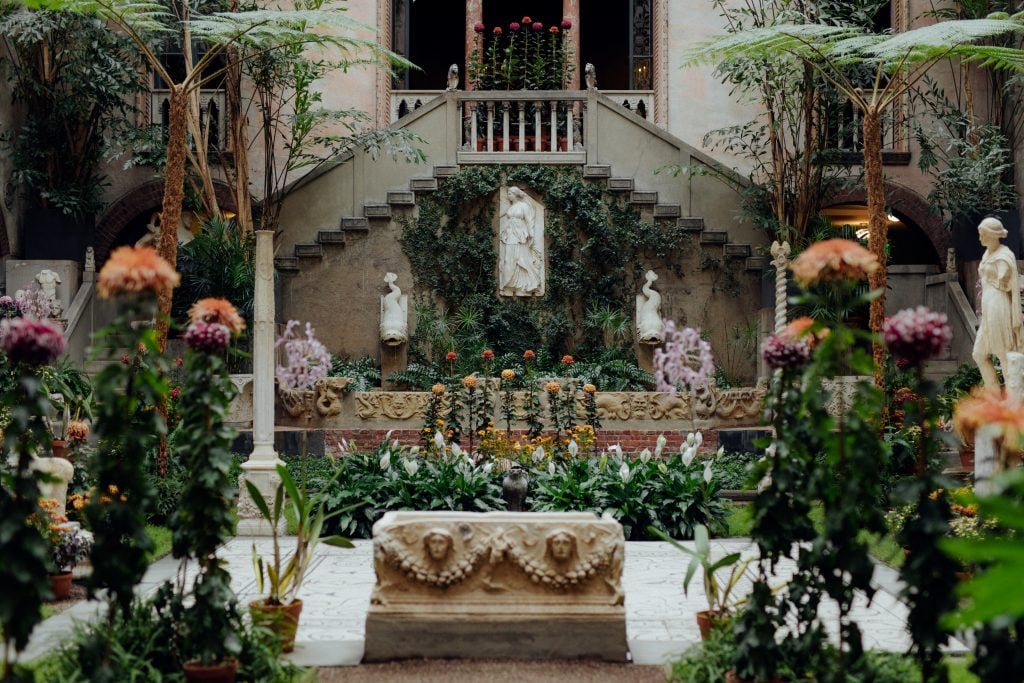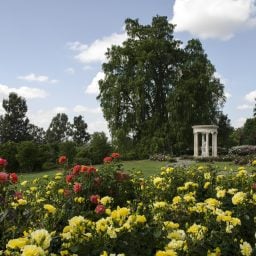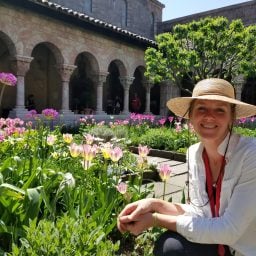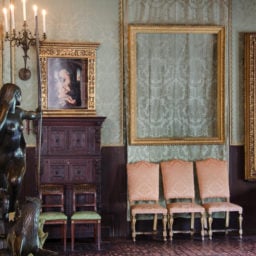Is there any American art institution more steeped in mystery and intrigue than Boston’s Isabella Stewart Gardner Museum?
Born in 1840, Isabella Stewart Gardner, the museum’s founder and namesake, was easily one of the most colorful and talked-about women in Boston society. A dedicated patron of the arts, she collected works by the likes of Titian, Rembrandt, Michelangelo, Botticelli, Manet, Degas, and John Singer Sargent, with whom, over the course of 30 years, she became especially close. She kept all her treasures—artworks, antique furniture, and correspondences with great thinkers of the day—in a castle built especially for her collection.
Constructed by the architect Willard T. Sears, who modeled the property on the Renaissance palaces of 15th-century Venice, Gardner intended for her palace to be a place for celebrating art in all its forms, and routinely hosted musical performances, lectures, and art exhibitions in the courtyard.
In the public imagination, however, the museum has come to conjure more than Gardner’s famous salons and riotous parties. In 1990, 13 of the museum’s more precious artworks, valued at around $500 million in total, were stolen, and the unsolved crime continues to be arguably the most mysterious art heist to date. Nonetheless, the Gardner remains one of the most visually arresting museums in the world, in no small part because of its storied courtyard gardens that comprise the institution’s “living collection” and are maintained just as carefully as its artworks.
Recently, Artnet News spoke to the Gardner’s director of horticulture, Erika Rumbley, while she was installing the museum’s courtyard holiday display. She told us all about what it takes to be a grower at one of the country’s most visited art institutions.
Tell me about how you first became interested in horticulture.
I’m originally from North Carolina. Alongside theater through my 20s—initially I wanted to be a playwright—I was working with plants as a sort of side gig, and eventually I realized that the plants should take center focus. I’ve always been an organic grower—I’m passionate about sustainability and growing the highest-quality plants possible using ecologically responsible methods—and so I think one of the driving forces of my career has been working in season extension in New England to grow really gorgeous plants. I love the challenge of growing in greenhouses and high tunnels and cold frames, and the push and pull of manipulating the lifespans of plants, especially around the shoulder seasons, while keeping them healthy. I just think the challenge of doing that as a grower is really difficult and fun and engaging. It’s really physical work; it’s also about paying close attention, which is of course something that grounds the visual arts as well.
So how did you land up at the Gardner?
I came to the Gardner three years ago to be mentored by Stan Kozak, my predecessor. He’s the one largely responsible for the magical world of the Gardner from the perspective of the living collection in and around the palace, which he planned to heighten and build out the experience of the art collection in each of the rooms. He was a meticulous grower and helped preserve the heritage seedlings and cuttings that were part of Isabella’s original garden. We’ve carried on those traditions: the chrysanthemum show that’s on now through the holidays pays homage to her favorite flower and looks to be, right now anyway, a great example of what that plant can do—how high they can reach, how rich their colors can be.
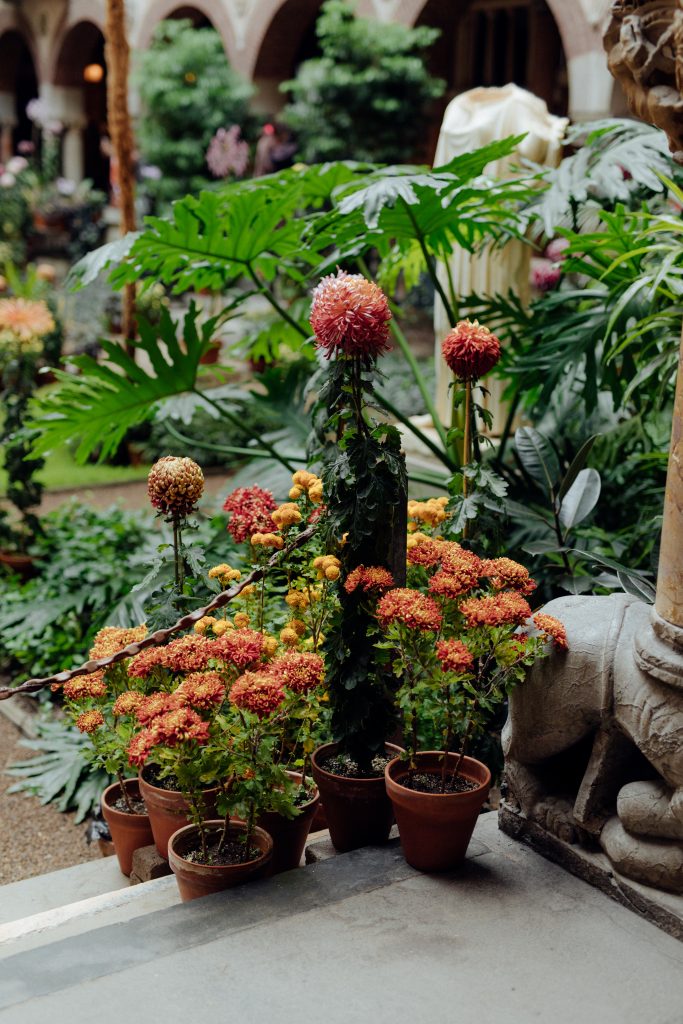
A closeup of the chrysanthemum show in the courtyard. Photo courtesy of Ally Schmaling and the Isabella Stewart Gardner Museum.
It’s really rare for a collection to be this broad, and that’s ultimately what has always attracted me to the Gardner, from a grower’s perspective. For someone to be like, “Yes, I work with orchids and tropicals and all these plants from seeds, and there are also shrubs and natives and trees in the collection,” as Stan did, just seemed crazy to me in the best way. It’s all over the place.
Did you have any relationship to the museum before you started working there?
I’d been going to the Gardner as a visitor and a member for about a decade before I came to work here. For me, as a visitor, I liked to come on my own as a place of respite. I mostly came in the winter—during my off season—and saw the orchid show, which was just this very welcome, bright tropical moment in the courtyard that staved off the winter chill for a while. I definitely was coming in on those days for a quiet, contemplative palette cleanser. I also really liked to come on Thursday nights just to be with people, when the parties on Thursday nights were really rolling.
It’s always felt like such a joyful place to be in Boston. So those are my two points of connection, and I’ve always appreciated the intricate collage that is Isabella’s installation in the palace. The entire palace is so layered and complex and just rewards looking, probably more than any other space I’ve ever been in. You never get to the bottom of your curiosity, and I think that’s one of the guiding principles of our redesign of the courtyard installations right now, just trying to build these evermore complex, otherworldly shows that, like the museum itself, rewards a wandering gaze.
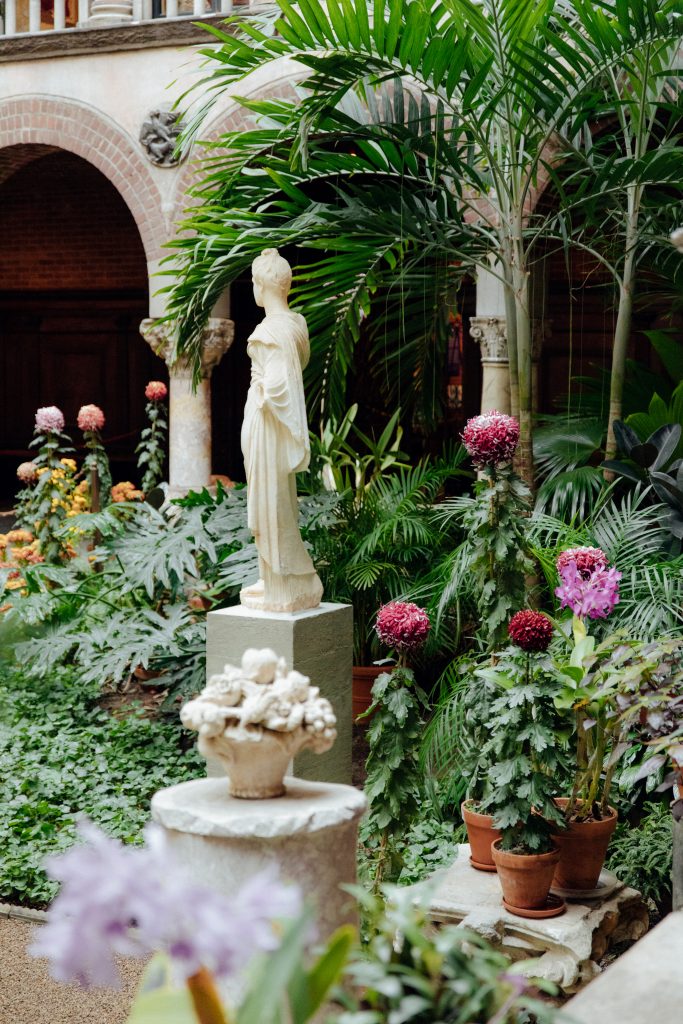
Photo courtesy of Ally Schmaling and the Isabella Stewart Gardner Museum.
It really is unlike any other space I’ve been in. Stepping into the courtyard and palace feels surreal, like you’re about to disappear into Narnia or something. Every consecutive visit seems to offer something new, especially as far as the artwork is concerned.
I remember the first time I installed the nasturtium display, which was for my first show with Stan. They’re notoriously needy plants; they take a year to grow and we have them tumble down from our balconies down to the courtyard below, which is very sort of Romeo and Juliet, if you think about it. It takes four to five people to carry each plant, bridal train-style, up the stairs of each floor, and I remember walking up stairs that year and Stan, looking up some metal work had caught his eye, and he was like, “Oh, I’ve never seen that before.” At that point, the man had been working at the Gardner for 48 years. He’d spent his entire adult life in this museum learning its every nook and cranny, and that he could still look up and say, “Oh!” is incredible to me.
It’s just such a generous building and it keeps giving you new things. And we try to build off of that and give these little gifts to visitors. We’ll build these little vignettes in corners that you can’t see from most positions; they’re intended for you to sort of come upon. You’ll walk around the corner and find this tiny collection of a few spotted orchids, or something scented maybe, something you’ve never seen before. I feel like we’re trying to replicate the feeling in the palace of walking around the corner and into a room you didn’t know was there and being like, “This artwork is here? How can that be?” That sort of astonishment, that it just doesn’t seem possible that the work is right in front of your face.
Sort of like a lifesize cabinet of curiosities.
Yes! People call it the jewel box, actually, which feels so right to me.
You’ve mentioned that you’ve spent some time lately redesigning the program. Tell me about that.
One of the biggest changes this year is that we’ve redesigned the late winter/early spring show to focus on bulbs, so we just finished about a week ago tucking more than 7,000 bulbs into an insulated shipping container in Hingham, in 1,300 terracotta pots. We’ll start pulling them in January, at which time they’ll begin to bloom, and it’ll be the largest bulb display in the courtyard since the Great Depression. In terms of numbers and sheer saturation of flowers in the courtyard, we’re really trying to push the envelope and make it exuberant and over the top—a sort of visual explosion of color for people, which hopefully will be really encouraging and life-giving after a year like this.
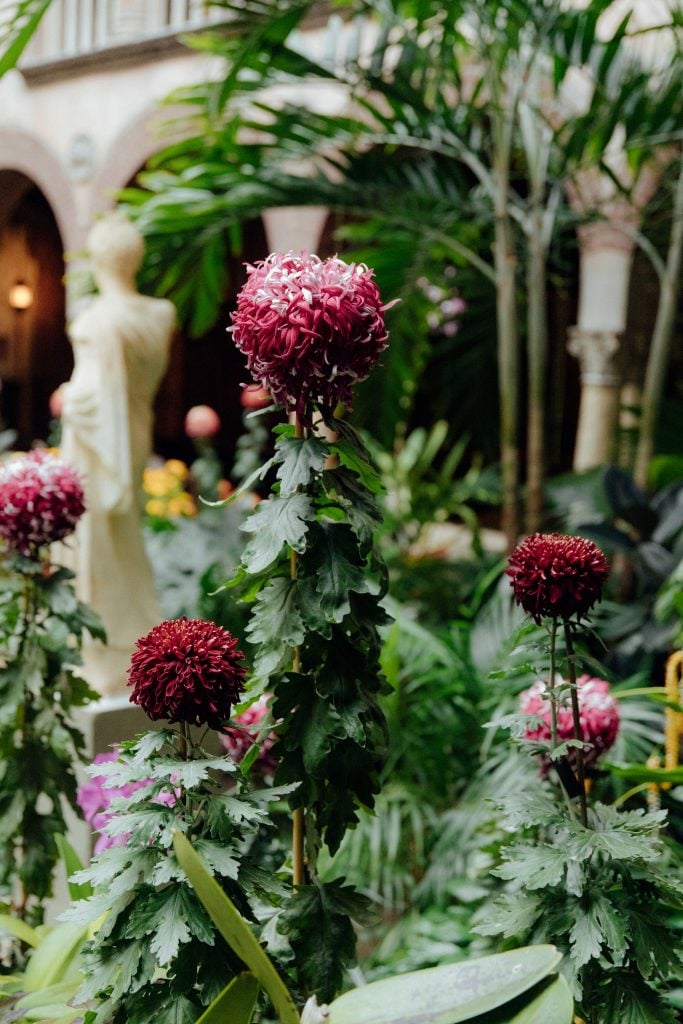
Photo courtesy of Ally Schmaling and the Isabella Stewart Gardner Museum.
Can you tell me what it’ll look like?
That time of year is known for being mostly about tropical plants, so in terms of foliage, it’s really glossy and then we’ll have orchids that range from pale yellow to these deep rusty oranges—cymbidiums and lady slippers that also range from a rich yellow to a kind of deep burgundy. That’ll be the palette for the orchid display, and then we’ll add what’s growing from these 7,000 bulbs to be shown alongside them. We’ll have muscari and daffodil and tulip, and then we’re also growing some less common, more Seussian, otherworldly, strange, “Who are you?” bulbs. Things like Fritillaria or Camassia—these are flowers that look more wild or impossible. They’re not as productive as some of the other bulbs, but to me they help round out the experience in the courtyard and keep the magic of the palace alive.
So what does a typical day look like these days?
We’re always split between two locations, the nursery and the museum, which is tricky. It just means that we have to collaboratively manage this complex collection that’s in two locations, 45 minutes apart. That as a baseline is tricky. Our days always start at 7:30 a.m. In the summer, that means we’re hitting the ground watering. This time of year, it’s a good time for pruning and we’re doing a lot of work on foliage plants, and getting orchids staked and ready for their show next month.
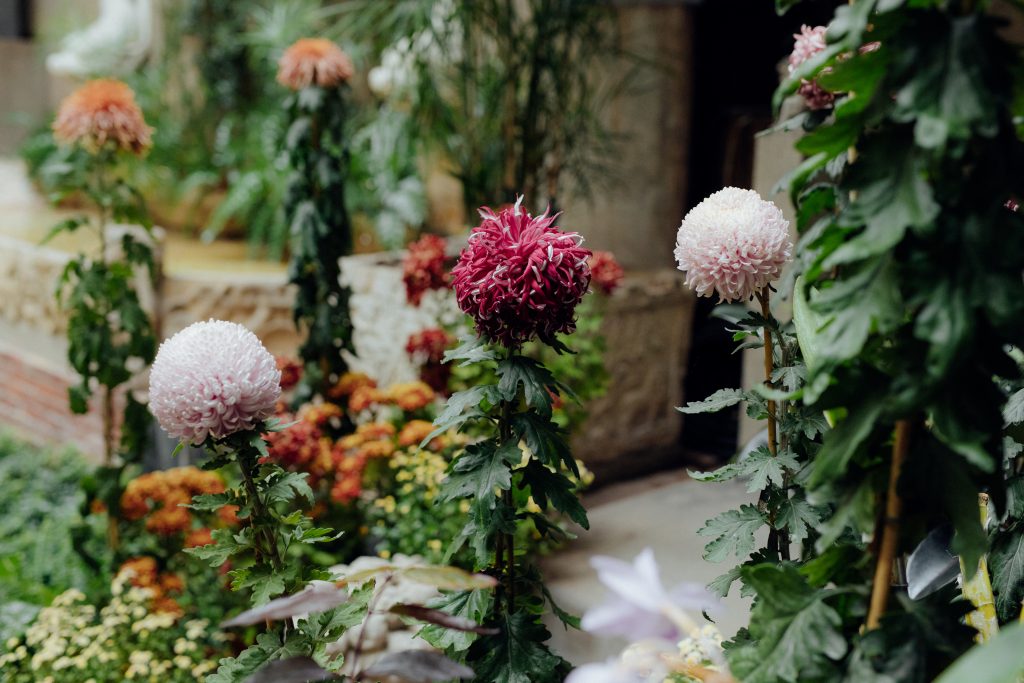
Photo courtesy of Ally Schmaling and the Isabella Stewart Gardner Museum.
What’s one thing you’d like readers to know about what you do?
I think that the biggest misconception about the space is that it doesn’t change. Because people know that about the building already, they kind of transpose that idea onto the courtyard displays, but the beauty of the courtyard is that we have so much space to play and to improvise and so I think our job as growers is to take a beloved structure and continue to surprise.
You know, there’s legacy plants associated with every season, too—there’s nasturtiums that many Bostonians associate with the start of spring. There’s the Campanula pyramidalis in the summer—these over-the-top, wild, six-to-seven-foot spires covered in hundreds of blooms. There are certain pieces that are like, “Why would we change that?” But around those main characters, every single show that we’re redesigning we’re trialling new material to make the palette even more rich to just try to give people an even more surreal experience to complement, in a sense, the diversity of the artwork and the lore of the museum. I guess our work is a weird mixture of so much planning—we know what we’re going to do many years in advance—and then in the moment having to improvise. So we set these 25 things in motion at the beginning of the season, and now we have to say, “Okay, what are the plants actually doing? How is all this working out? And then let’s install the best of what is performing this week and give it to people in the most beautiful way we can.” I think people often think that there’s a formula, but a formula with plants is impossible.
